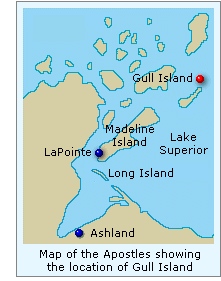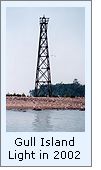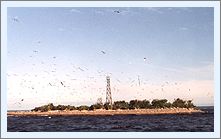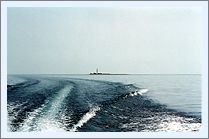|
Historical Information

Gull Island is a small sliver of
rocky land, barely breaking the surface of Lake Superior a scant ¼ mile
off the Northeast point of Michigan Island. As the only exposed portion
of a shallow rocky ledge extending almost three and a half miles in a
northeasterly direction from Michigan Island, the ledge represented a
hazard for any vessel with a draft greater than that of a canoe moving
through the area.
Considering various alternatives to
warn mariners of the danger that the ledge represented, in 1906 the
Lighthouse Board recommended that Congress appropriate the sum of
$85,000 for the construction of a light and fog signal to mark the tiny
island. Unfamiliar with the practicalities of the situation, Congress
referred the matter to the Department of Commerce for additional
investigation. In its response, of February 1, 1907, the Department of
Commerce reported favorably on the proposal, noting in part that
"Several vessels have run aground in this vicinity during storms.
If there had been a light and fog-signal there, the wrecks might have
been prevented."
 Wary of such a large appropriation, on
May 14, 1908 Congress instead allocated $2,000 to fund a complete survey
of the area, and Eleventh Lighthouse District Engineer Major Charles
Keller dispatched a survey crew, which completed its' work that
September. Upon evaluation of the crew's findings, Keller modified his
plan, recommending in his annual report for 1909 that the easterly end
of Michigan Island would in fact represent a preferable site for an
improved light and fog signal, and requested that the amount of the
appropriation be increased to $100,000 to cover the associated costs. Wary of such a large appropriation, on
May 14, 1908 Congress instead allocated $2,000 to fund a complete survey
of the area, and Eleventh Lighthouse District Engineer Major Charles
Keller dispatched a survey crew, which completed its' work that
September. Upon evaluation of the crew's findings, Keller modified his
plan, recommending in his annual report for 1909 that the easterly end
of Michigan Island would in fact represent a preferable site for an
improved light and fog signal, and requested that the amount of the
appropriation be increased to $100,000 to cover the associated costs.
On June 17, 1910, Congress passed an
act approving the construction of the new station on Michigan Island.
However with the unsettled atmosphere surrounding that year's
abolishment of the Lighthouse Board and the transfer of responsibility
for the nation's aids to the newly formed Bureau of Lighthouses under
George R Putnam, no expenditure was approved. However, Putnam evidently
concurred with the need for the new station, and reiterated the plea for
the appropriation in his annual reports for each of the following eight
years.
In 1918, plans were underway for the
installation of a pole light at Schooner Ledge Rear Range Light on the
Delaware River in Pennsylvania. With the erection of the new automated
light, the old 112-foot cast iron skeletal tower would no longer serve
any purpose. Determining that the cast iron tower was in excellent
condition, the Bureau of Lighthouses proposed that the old tower be
disassembled and shipped to the Eleventh District for re-erection on
Michigan island, thereby eliminating a large portion of the cost
associated with building the new coast light there. The Michigan Island
plan was thus modified to include a radio beacon instead of the more
expensive diaphone fog signal and the construction of an unmanned
acetylene light on Gull Island, thus reducing the total estimated costs
for construction to $85,000.
Congress finally came through with the
appropriation in 1928, and work began that same year on both Michigan
and Gull Islands. Of the total appropriation, $9,495 was allocated to
the construction of the unmanned light on Gull Island.
 Consisting
of an open 50-foot tall skeletal iron structure, the metal work was
painted black to increase its effectiveness as a daymark. A 375 mm
acetylene powered light was installed atop the structure, emitting 390
candlepower and sitting 55-feet above the lake's surface, the light was
visible for a distance of 13 miles in clear weather conditions. Equipped
with an automatic sun valve, the light was to operate untended. Designed
to automatically shot off the flow of gas with the warmth of day and
reopen the flow at dusk, the sun valves proved cantankerous, requiring
frequent re-lighting and adjustment. As a result, maintenance of the
light was added to the list of responsibilities for the Michigan Island
Light keepers, who were required to observe and record the visibility of
the light on a daily basis and to either make necessary repairs
themselves or notify the appropriate personnel in Duluth of any problems
encountered that were beyond their own ability to solve. Consisting
of an open 50-foot tall skeletal iron structure, the metal work was
painted black to increase its effectiveness as a daymark. A 375 mm
acetylene powered light was installed atop the structure, emitting 390
candlepower and sitting 55-feet above the lake's surface, the light was
visible for a distance of 13 miles in clear weather conditions. Equipped
with an automatic sun valve, the light was to operate untended. Designed
to automatically shot off the flow of gas with the warmth of day and
reopen the flow at dusk, the sun valves proved cantankerous, requiring
frequent re-lighting and adjustment. As a result, maintenance of the
light was added to the list of responsibilities for the Michigan Island
Light keepers, who were required to observe and record the visibility of
the light on a daily basis and to either make necessary repairs
themselves or notify the appropriate personnel in Duluth of any problems
encountered that were beyond their own ability to solve.
The light continued to operate under
acetylene power until some time in the 1950's, when it was electrified.
Today, a 250 mm 12 volt DC solar-powered optic flashes the same
10-second characteristic seven miles across Superior, warning the many
pleasure boaters who now throng the area every summer of the danger
lurking just beneath the water surface.

Keepers of
this Light

This light was maintained by the
keepers of the Michigan Island Light Station. Click
here to see a complete listing of all Michigan Island Light
keepers compiled by Phyllis L. Tag of Great Lakes Lighthouse Research.

Seeing this Light

For five days
in July, 2002, we were privileged to serve as NPS volunteers, assisting
Park Historian Bob Mackreth in documenting the condition of all the
Apostle Islands Lights. Returning to harbor after visiting Outer Island
on our first day in the National Park, we swung south toward Gull
Island. As we approached the island from the west, it quickly became
evident that the island is aptly named, as hundreds of gulls and
cormorants took to the air, circling overhead and screaming for us to
leave their resting site.
With a slight breeze
from the east, we quickly became aware of the strong odor emanating from
the island, and quickly shot a few photographs before turning to head
for the cleaner air of open water, leaving the island "for the
birds."

Finding this
Light

Although Apostle
Island Cruise Service offer cruises by the main Apostle Island
light, they do not currently offer any cruises which pass new Gull
Island. Thus, a private boat is the only way this island can be
seen.

Reference Sources

Congressional Record, 1907
Annual reports of the Lighthouse Board, 1907 through 1909
Annual reports of the Lighthouse Establishment, 1910 through 1929
Annual report of the Lake Carriers Association, 1929
Great Lakes Light Lists, various, 1939 through 1997.
Great Lakes Pilots, 1958 and 2000.
Keeper listings for Michigan Island Light appears
courtesy of Great
Lakes Lighthouse Research
|

